By Jenny Linger, Vegetable Production Co-Manager
Rosa Villegas, Vegetable Production Co-Manager, contributed to this article
As a year-round agricultural production center, the Hudson Valley Farm Hub is in perpetual motion. With full season extension and winter storage, crops that are sown in one year or season can be harvested in the next. Thus, the vision for one year is born in the ones before. Over the last nine seasons (since the Farm Hub started in 2013), the production plan has been molded by varied farmer paradigms, program goals, growth aspirations, field conditions, labor constraints, and, ultimately, a language of the land. Being a non-profit enterprise, our modus operandi is unique – to serve the community, locally and regionally, as sustaining stewards of these soils ecologically and socially. Between these two overlapping aims are facets of life touched by the seeds that we sow – from our partners in schools, universities, pantries, farmers’ markets, groceries, bakeries, and cafes to our co-inhabitants in deer, bears, birds, turtles, insects, marshes, and creeks – and all parts of our food system.

Conservation and regenerative practices have been the foundation of our land restoration and sustainment. Having made the transition in 2013 from conventional herbicide-based practices to organic cultivation-based methods, our focus has been on keeping soils covered whenever possible, rotating crop families, and reducing tillage. A near decade later, our plans still reflect our interest in supporting both formal and practical research to information systems and technology that build climate resilience, alongside our commitment to supply nearly a half million pounds of fresh organic produce and dry goods to our food access partners year-round. Our emphasis on data collection over recent years has enhanced our decision-making tools and, through encouraging trends, increase no-till acreages by more than 50% for crops like dry beans and spring-planted small grains.
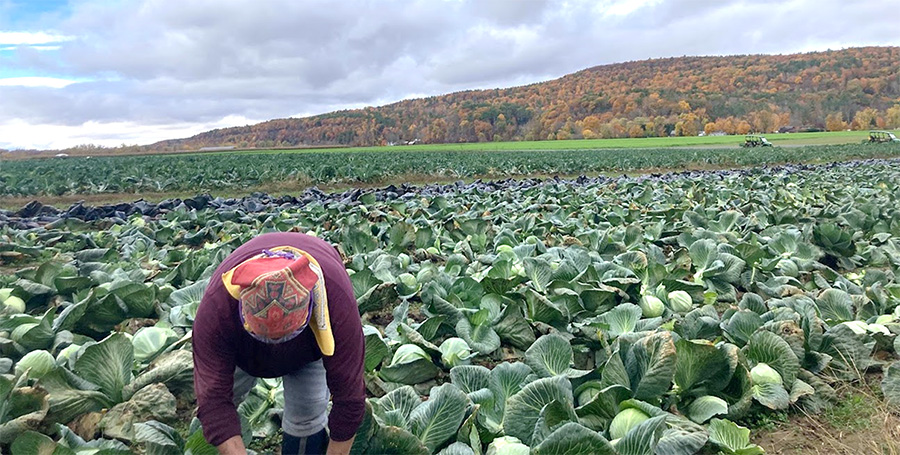
As we steadily build our production systems, it’s equally important to think about how we evolve and adjust to sustain our team’s bodies and trajectories. I’ve estimated that in one year, a single vegetable production team member lifts over 50,000 pounds of produce. As a team of ag professionals ranging in age from 22 to 61 years old, our collective experience totals more than 175 years, covering a geography of six states and five countries. The miles of shuffled steps needed for precision hand hoeing implements for mechanized harvest, and bed feet of row cover are factors that have implications – all deeper and lighter shades of gray, but reasons to think carefully and humbly about the work that we ask of ourselves and others in organic systems. In the lull of winter, the vegetable production team reflects, analyzes, and brainstorms around the weakest pain points in cropping systems, varieties, equipment, and the cohesive plan. For the coming year, we are thinking about efficiencies and informal research in the field including curing onions, mechanical mulch winding, and how to strategically synchronize irrigation (rainfed and manual) with cultivation.
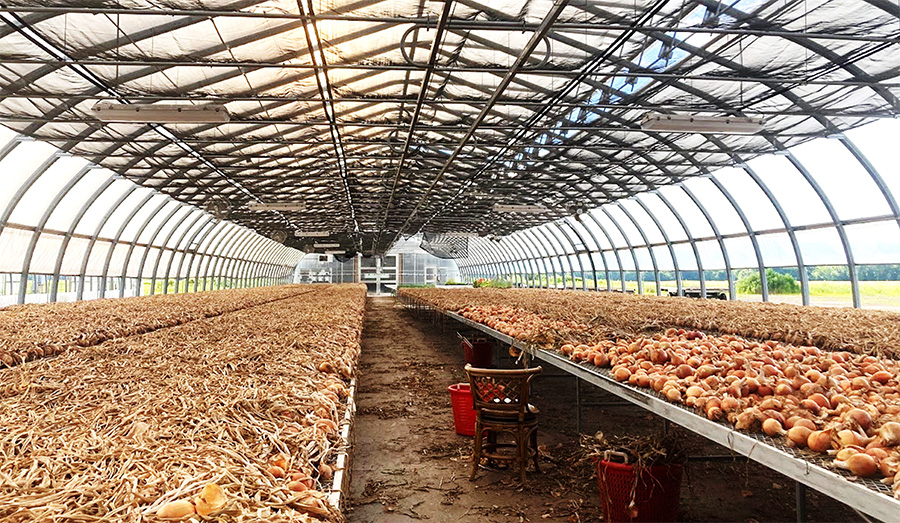

This year’s vegetable production plan resembles recent years as the rotation returns to field P45 after being planted with cover crop and small grains for two years.
P45 is a field familiar to those of you who drive or cycle by the short end of the 34-acre field seen around the bend on Hurley Mountain Road near Dug Hill Road.
The last season that vegetables were grown in those soils was 2020 and we’ve spent the last two years cover cropping and growing small grains to add organic matter and diversify the soil’s nutrient and root profile. The three-quarter acres of fall-planted hard-neck garlic is the anchor to the 49 other 50’-wide sections of oat pea, rye, and bare-fallowed ground. We’ll be adding a planting of asparagus at the top of the field at the marsh’s edge. The water-loving fern is one of the few common perennial vegetables in the northeast, which after becoming established for a few years, can be harvested for decades.
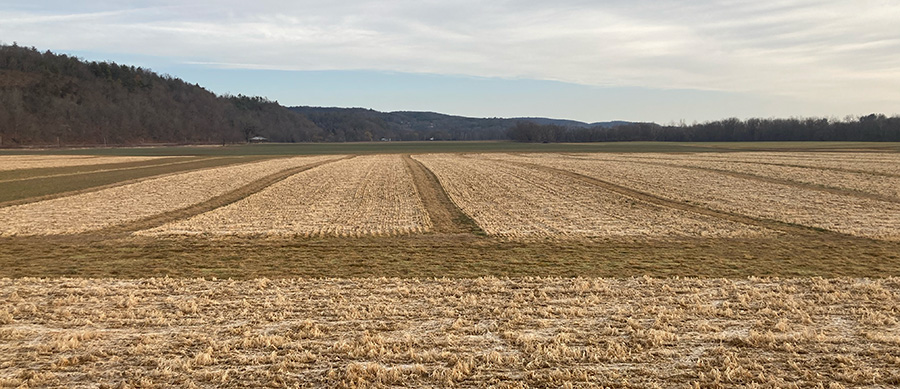
Come spring, the rye, and spring-planted pea sections will be rolled for no-till plantings of musk melons, watermelons, winter squash, and green beans. No-till can be a risk for organic growers between weeds, wetness, pests, and what can be reduced yields. However, it can also provide weed control, moisture management, and a way to feed more organic matter (re: humus – the life force of soil) into vulnerable tilled lands. In the arc of climate transition, our production teams support both institutional research and the practical questions of how we should assess, calibrate, and iterate crop treatments to anticipate environmental changes and the need for building long-term soil health in the Hudson Valley. Our research partners at Cornell Cooperative Extension are helping us investigate Greenhouse Gas Flux between varied tillage and preparation treatments and their effect on yield, quality, and atmospheric impact.
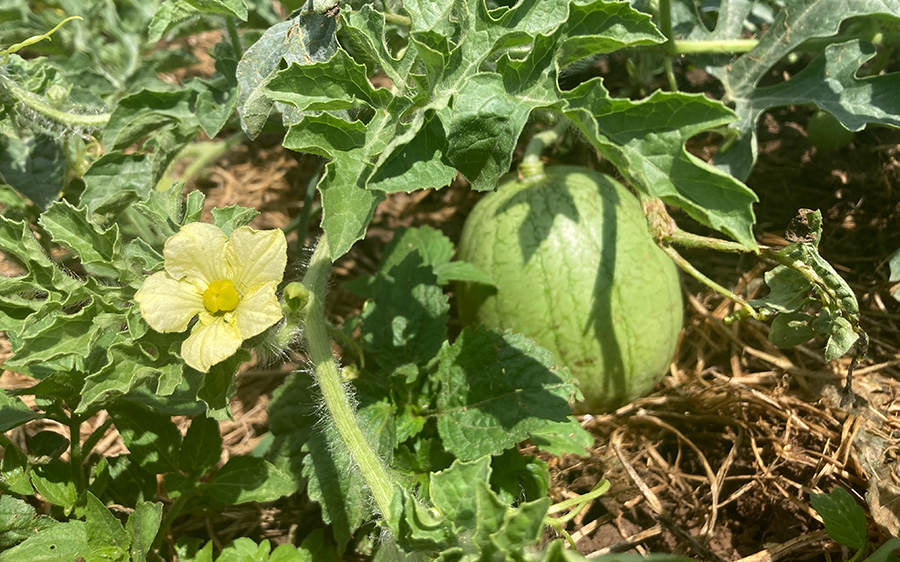
One of our practical cultural questions surrounds the use of plastic mulch. Our total musk melon and watermelon acreage will be increasing as we listen to our distribution partners’ requests for more fruit. With the expansion and the addition of a few new varieties, including Piel de Sapo (a white-fleshed melon), we’ve decided to look at different management methods – black plastic, no-till/zone till (into rolled oats and peas), and bare culture – and the considerations around which system (or combination), provides the most holistic benefit in our desire for cost-effective yields, complimentary labor systems and resource management, increased soil health, and waste consciousness. Black plastic mulch helps heat the soil for warm climate-loving crops; requires more efficient irrigation in the use of drip tape; prevents soil compaction from extra cultivation passes; and generally, saves labor spent cultivating by machine or hand. However, its use has been highly debated in ecological farming and often criticized for its material waste impact, though organic certifiers have yet to clear the use of bioplastic (biodegradable/compostable) films as an alternative zero-waste product. Our partners at CCE are looking at this research question in sweet potato production, a crop that benefits from warm, moist soil. We currently plant onions into a reflective silver mulch that serves as a physical deterrent to a common and damaging pest called thrips, while also increasing photosynthesis and keeping soil temperatures down in the heat of midsummer.

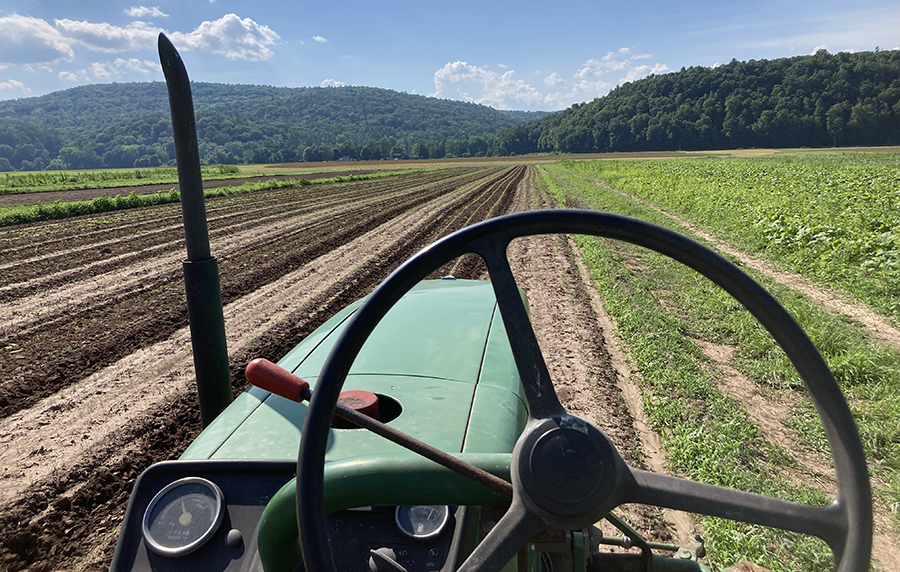
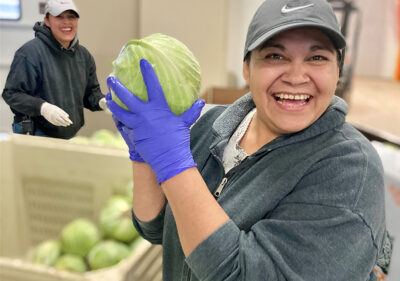
Sweet corn, broccoli, green beans, and carrots will continue to lead in acreage as readily mechanically cultivated summer crops. Most of our cropping systems are oriented toward tractor cultivation to maximize productive, diversified acreage with a team of 12. Though, as our team can attest, sweet potatoes and potatoes persistently require often arduous hand cultivation throughout the season and thus, they compose only about 15 percent of our crop plan. While we have our mainstay varieties, our rainbow array of storage potatoes is widening to include the purple-skinned and fleshed ‘Blackberry’; pink-skinned, white-fleshed ‘Strawberry Paw’; and the yellow-skinned and fleshed ‘German Butterball’. At times, the wet conditions of late spring make early potato cultivation timing difficult and resultingly, we’ve been flame weeding, just as what’s typically done with carrots and parsnips, to incinerate the weeds ideally while they are less than an inch tall without harming the main crop.
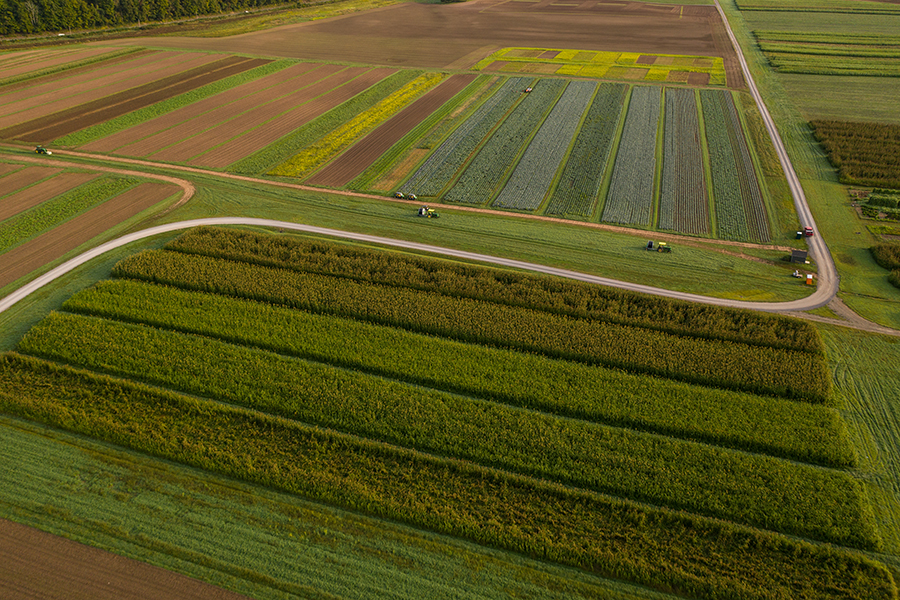
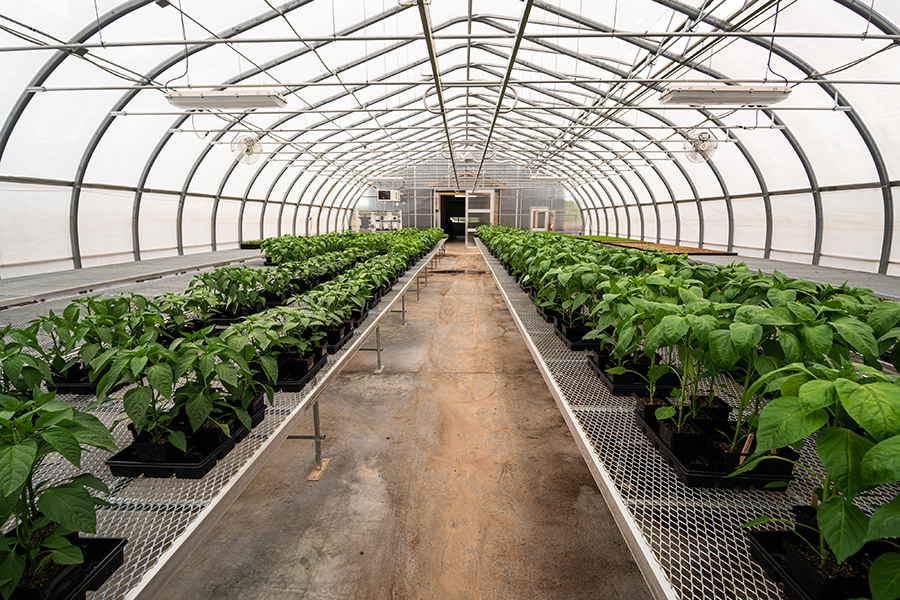
From onions to parsnips, cabbage to cauliflower, broccoli to beets, our plantings, and successions line up to include more than 120 varieties of about 40 vegetables. Most of our crops are held in storage for distribution throughout the winter when fresh produce is most difficult to find in pantries or food banks. However, this year we’ll be trialing small amounts of fresh harvest warm-season crops like basil, tomatillos, white onions, green onions, ginger, and scallions to add more diverse crops with multicultural relevance to our spring and summer offerings of sweet corn, broccoli, tomatoes, melons, and peppers to our donation partners.
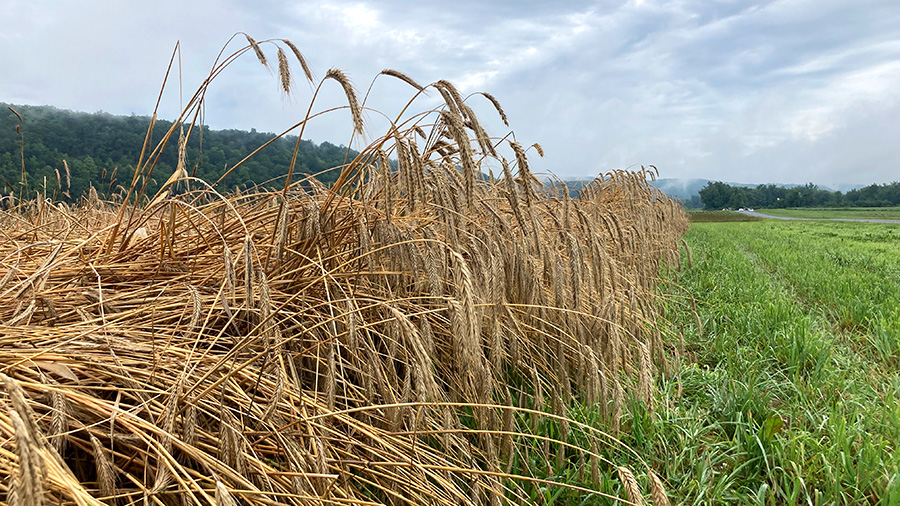
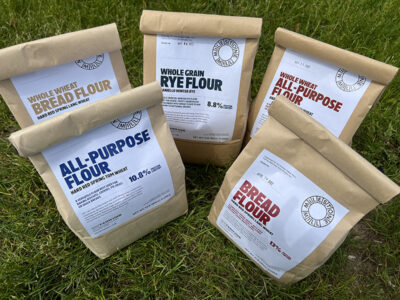
Small grains made a successful debut in the vegetable field rotation last year. The production plan sowed annual grains— spring and winter wheats, rye – into our off-season vegetable fields, occupying the second year in a three-year rotation. By following vegetables with field crops, we can maximize our investment in the pre-plant application of nitrogen-heavy aged chicken manure for vegetable crops. The deeper root profiles of grasses mobilize nutrients and spur a more diverse soil life while bearing a marketable crop and additional farm revenue for diversified vegetable farmers.
We have been growing small grains in the vegetable fields for at least two years now. 2022 was the first year we planted the entire field to small grains as we hosted a trial looking at side-by-side plots of roll and crimp no-till small grains next to small grains planted in bare ground. With no clear differences in quality, it shows us that no-till does not reduce a yield or quality, and in the instance of spring wheat saw a slight increase in yield per acre within the no-till plots.
These field crops, as well as, black and pinto beans, grain corn, and cover crops are integral parts of our 800-acre field rotation and support the regional mill project, Milestone Mill. Over the last few years, the Farm Hub has been incubating the Mill, now its own non-profit enterprise, while building a granary to process human-grade grains and increase our capacity in color sorting varied grains and legumes. This infrastructure is critical in making high-quality seed and milled products. Color sorters use cameras to identify and eject defective, miscolored product or contaminants within a stream of product that can clean up to 2,500 pounds per hour. We will continue to blend organic production methods with regenerative approaches to offer healthy yields in support of Milestone Mill’s array of local, co-packed products as a cornerstone of their regional grains supply chain.
Because the farm prioritizes soil health, we seek to incorporate fast-growing cash crops that allow us to put in a cover crop the same year. For that reason, the Field Crops Team will be adding almost 100 acres of Field Peas to the spring planting list. As a legume, Field Peas fix nitrogen, while their seed – the peas themselves — also transfer that into the animal nutritive form of protein. Notably, Field Peas are planted first thing in the spring, and are harvested in early summer, allowing the farm to yield a marketable crop in time to plant a soil-building cover (or alternatively another short-season cash crop) ahead of the following year’s small grains. This sets us up to grow more no-till wheat. Soybeans, another legume, are harvested too late to allow for a roll and crimp(able) winter rye cover to establish. Additionally, unlike soybeans — which require roasting before grinding into feed — field peas do not need to be processed. That saved extra step represents both energy and cost savings to feed mills or farmers that mill their own feed, while maintaining palatability and nutrition for pigs, chickens, and cows. While it is going to be a learning year, we hope to have enough success with Field Peas in 2023 to incorporate them into our field crops rotation in the future.
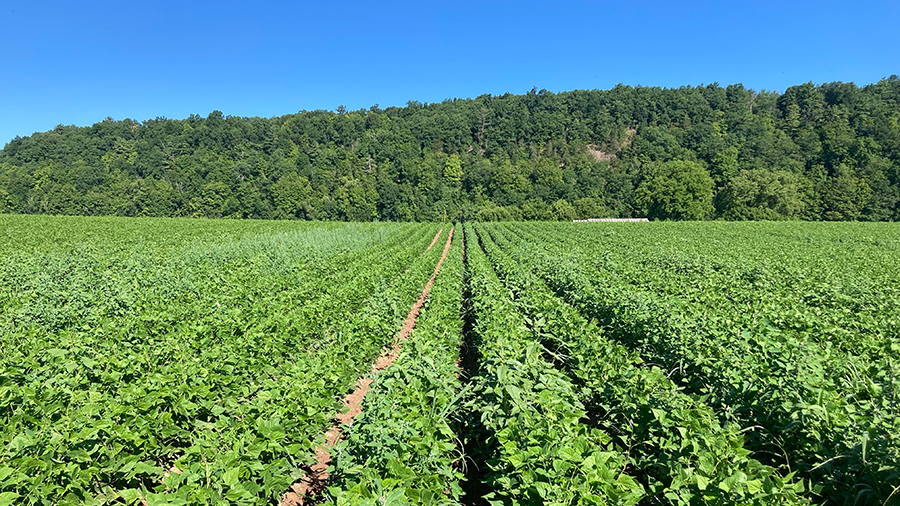
The significance of field crops – grains and legumes – in yesterday, today, and tomorrow’s food systems extends well beyond their agroecological function. They are naturally relatively low in carbon inputs because they can be stored for months without energy expenditure and perform better in rainfed conditions than vegetables. Our no-till research trials are trying to push the envelope on how little soil disturbance is possible in a multi-year window. They are generally both food products and seeds, so no divergent care or infrastructure must be taken to procure and save seed, just cleaning. Finally, together they contain complete proteins and are vitamin and mineral-rich sources of carbohydrates, essential clean-burning energy in our diets. The Kernza trials help to further understand the sustaining potential for small grain production in the future as we think about multi-purposed cropping systems embodying food production, forage, and habitat.
The weed zapper and interrow mower are contemporary implements that will be highlighted this season in the production of black and pinto beans and the latter in this year’s research trials. The large field crops acreages and increasingly challenging climate conditions can make cultivation timing a difficult operation with increasingly erratic weather patterns and traditional tools. If critical initial cultivations are missed, then it is at times impossible to kill maturing weeds, especially as they enter reproduction. The mower and zapper provide options to physically limit weed growth through the former mowing weeds or an intentional green cover between rows and the latter sends an electrical shock through in-row weeds to kill them. Both limit harmful competition with crops and increase the soil seed bank.
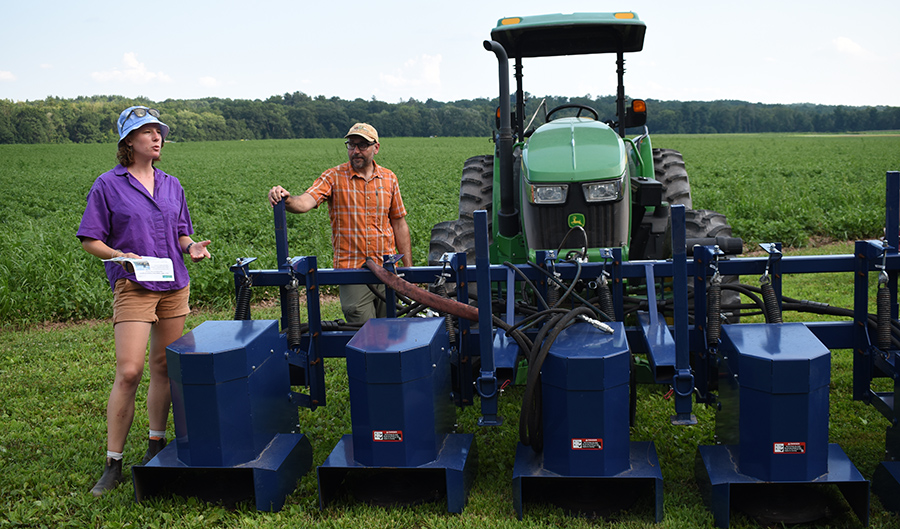
A mild winter with relatively light snowfall made this spring equinox and awakening warmth feel prescient. It’s an abrupt transition that makes every farmer wonder about the plans laid — decisions embedded in cotyledons pushing through the greenhouse potting soil and vermiculite, seed varieties, and accompanying lot numbers pasted into the fertile cells of spreadsheet workbooks going back years. How well have we prepared for the unknown curves of seasons — temperatures, diseases, precipitation, and winds? is now the question that we as land workers face. Our hope is that with the space, ability, knowledge, and resource to integrate sustainable indigenous practices into cropping systems and infrastructure on the farm, we are continuing a cycle of generating productivity and resilience on this land.
Enjoy a timelapse of Pea Shoots from seed to harvest captured by Ernesto Villegas a member of our production team.
